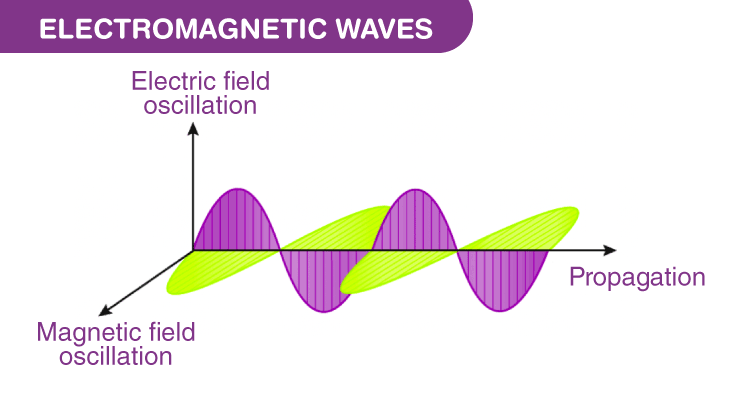Electromagnetic Waves Definition Electromagnetic Waves Formation Electromagnetic Wave Equation Electromagnetic Spectrum
What are Electromagnetic Waves?
Electromagnetic waves are also known as EM waves. Electromagnetic radiations are composed of electromagnetic waves that are produced when an electric field comes in contact with the magnetic field. It can also be said that electromagnetic waves are the composition of oscillating electric and magnetic fields. Electromagnetic waves are solutions of Maxwell’s equations, which are the fundamental equations of electrodynamics.
How are Electromagnetic waves formed?
- Generally, an electric field is produced by a charged particle. A force is exerted by this electric field on other charged particles. Positive charges accelerate in the direction of the field and negative charges accelerate in a direction opposite to the direction of the field.
- The Magnetic field is produced by a moving charged particle. A force is exerted by this magnetic field on other moving particles. The force on these charges is always perpendicular to the direction of their velocity and therefore only changes the direction of the velocity, not the speed.
- So, the electromagnetic field is produced by an accelerating charged particle. Electromagnetic waves are nothing but electric and magnetic fields travelling through free space with the speed of light c. An accelerating charged particle is when the charged particle oscillates about an equilibrium position. If the frequency of oscillation of the charged particle is f, then it produces an electromagnetic wave with frequency f. The wavelength λ of this wave is given by λ = c/f. Electromagnetic waves transfer energy through space.
Graphical Representation of Electromagnetic Waves

Electromagnetic waves are shown by a sinusoidal graph. It consists of time-varying electric and magnetic fields which are perpendicular to each other and are also perpendicular to the direction of propagation of waves. Electromagnetic waves are transverse in nature. The highest point of the wave is known as crest while the lowest point is known as a trough. In vacuum, the waves travel at a constant velocity of 3 x 108 m.s-1.
Mathematical Representation of Electromagnetic Wave
A plane Electromagnetic wave travelling in the x-direction is of the form
In the electromagnetic wave, E is the electric field vector and B is the magnetic field vector.
Maxwell gave the basic idea of Electromagnetic radiations, while Hertz experimentally confirmed the existence of an electromagnetic wave.
The direction of propagation of the electromagnetic wave is given by vector cross product of the electric field and magnetic field. It is given as:
Electromagnetic Wave Equation
- Electromagnetic wave equation describes the propagation of electromagnetic waves in a vacuum or through a medium.
- The electromagnetic wave equation is a second order partial differential equation.
- It is a 3D form of the wave equation.
- The homogeneous form of the equation is written as,
Where,
Intensity of an Electromagnetic Wave
Speed of Electromagnetic Waves in Free Space
It is given by
Where,
C is the velocity of light in vacuum = velocity of electromagnetic waves in free space =
Electromagnetic Spectrum

Electromagnetic waves are classified according to their frequency f or according to their wavelength
Wavelength ranges of different lights are as follows,
For visible light – approx. 400 nm to approx. 700 nm
For violet light – approx. 400 nm
For red light – approx. 700 nm
For more insights, stay tuned with BYJU ’s and fall in love with learning.

Applications of Electromagnetic Waves
Following are a few applications of electromagnetic waves:
- Electromagnetic radiations can transmit energy in vacuum or using no medium at all.
- Electromagnetic waves play an important role in communication technology.
- Electromagnetic waves are used in RADARS.
- UV rays are used to detect forged bank notes. Real bank notes don’t turn fluorescent under the UV light.
- Infrared radiation is used for night vision and is used in security camera.
Frequently Asked Questions
Name the property of an electromagnetic wave which is dependent on the medium in which it is traveling.
Velocity of an electromagnetic wave is a property which is dependent on the medium in which it is traveling. Other properties such as frequency, time period, and wavelength are dependent on the source that is producing the wave.
What is the wavelength of the photon of infrared light with the frequency 2.5 x 1014 Hz?
Since infrared light is a part of electromagnetic spectrum, the relation between the wavelength, frequency, and velocity is given by the formula:
Substituting the values, we get wavelength = 1.2 x 10-6m.
State if the given statement is true or false: Radio waves and X-rays both are on the electromagnetic spectrum and can travel at the same speed.
The given statement is true. Any wave from the electromagnetic spectrum travels at a constant speed of light. Other properties such as frequency, energy, wavelength vary depending on the type of wave and the source producing them. But the velocity remains constant.
What is the reason behind photons traveling at a speed of light while the other particles cannot?
Photons can travel at a speed of light while other particles cannot because they do not have mass.
State if the given statement is true or false: High frequency propagation is used so as to increase the accuracy.
The given statement is true. It is true that for increasing the accuracy, the frequency of propagation needs to be high.
What is the sequence for propagation of electromagnetic waves?
The sequence for propagation of electromagnetic waves is generation, propagation, reflection, and reception.




Very much helpful content is available on this site of Byjus